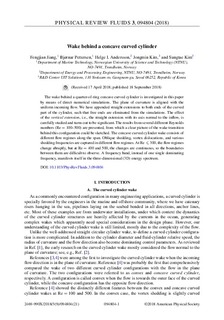| dc.contributor.author | Jiang, Fengjian | |
| dc.contributor.author | Pettersen, Bjørnar | |
| dc.contributor.author | Andersson, Helge Ingolf | |
| dc.contributor.author | Kim, Jongmin | |
| dc.contributor.author | Kim, Sungtae | |
| dc.date.accessioned | 2019-01-28T12:21:09Z | |
| dc.date.available | 2019-01-28T12:21:09Z | |
| dc.date.created | 2018-09-18T17:16:11Z | |
| dc.date.issued | 2018 | |
| dc.identifier.issn | 2469-990X | |
| dc.identifier.uri | http://hdl.handle.net/11250/2582622 | |
| dc.description.abstract | The wake behind a quarter-of-ring concave curved cylinder is investigated in this paper by means of direct numerical simulations. The plane of curvature is aligned with the uniform incoming flow. We have appended straight extensions to both ends of the curved part of the cylinder, such that free ends are eliminated from the simulations. The effect of the vertical extension, i.e., the straight extension with its axis normal to the inflow, is carefully studied and turns out to be significant. The results from several different Reynolds numbers (Re = 100–500) are presented, from which a clear picture of the wake transition behind this configuration could be sketched. The concave curved cylinder wake consists of different flow regimes along the span. Oblique shedding, vortex dislocations, and various shedding frequencies are captured in different flow regimes. At Re 300, the flow regimes change abruptly, but at Re = 400 and 500, the changes are continuous, so the boundaries between them are difficult to observe. A frequency band, instead of one single dominating frequency, manifests itself in the three-dimensional (3D) energy spectrum. | nb_NO |
| dc.language.iso | eng | nb_NO |
| dc.publisher | American Physical Society | nb_NO |
| dc.relation.uri | https://journals.aps.org/prfluids/pdf/10.1103/PhysRevFluids.3.094804 | |
| dc.title | Wake behind a concave curved cylinder | nb_NO |
| dc.title.alternative | Wake behind a concave curved cylinder | nb_NO |
| dc.type | Journal article | nb_NO |
| dc.type | Peer reviewed | nb_NO |
| dc.description.version | publishedVersion | nb_NO |
| dc.source.volume | 3 | nb_NO |
| dc.source.journal | Physical Review Fluids | nb_NO |
| dc.source.issue | 9 | nb_NO |
| dc.identifier.doi | 10.1103/PhysRevFluids.3.094804 | |
| dc.identifier.cristin | 1610740 | |
| dc.relation.project | Notur/NorStore: nn9191k | nb_NO |
| dc.description.localcode | © 2018 American Physical Society | nb_NO |
| cristin.unitcode | 194,64,20,0 | |
| cristin.unitcode | 194,64,25,0 | |
| cristin.unitname | Institutt for marin teknikk | |
| cristin.unitname | Institutt for energi- og prosessteknikk | |
| cristin.ispublished | true | |
| cristin.fulltext | original | |
| cristin.qualitycode | 1 | |
